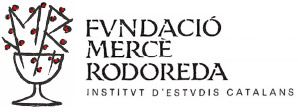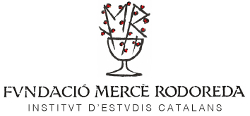Biography
Chilhood
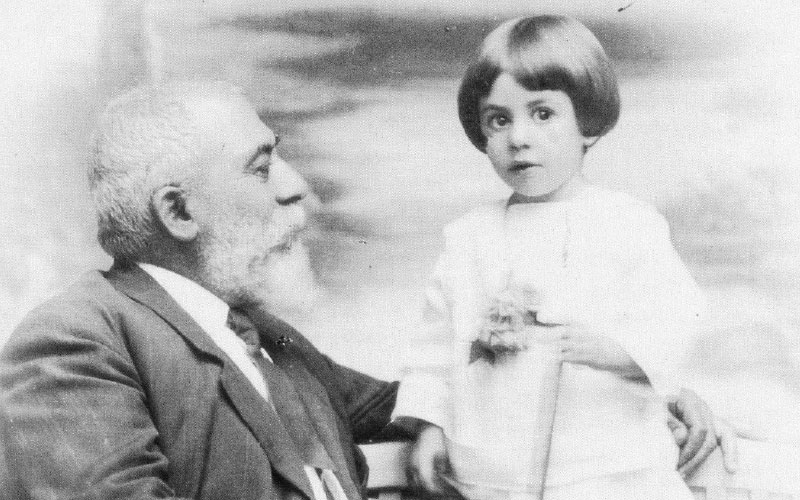
A Happy Childhood
Reproduction of the text: Carme Arnau. Mercè Rodoreda: un viatge entre paraules i flors (Mercè Rodoreda: a Journey through Words and Flowers). Girona;
Foundation Caixa de Girona, 1999. P. 7-16.
«I remember the feeling of being at home and, leaning over the rail on the roof terrace, I would see the blue jacaranda flowers falling on the lawn and the hydrangeas. I'll never be able to explain it; I've never felt as at home as when I lived in my grandfather's house with my parents»
Mercè Rodoreda «Images from Childhood»
In the 1974 prologue of Mirall trencat (Broken Mirror), Mercè Rodoreda wrote:
Linked to flowers, without flowers for years, I felt the need to talk about flowers, and to make my main character a gardener." And the thing is that, as this character says, “a gardener is different from other people, and this comes from dealing with flowers.” The author is referring to the fact that the first novel that she finished, after her long exile, was precisely, Jardí vora el mar (Garden by the Sea), whose main character is an old gardener, a story mainly set in a splendid garden, where all sorts of flowers proliferate, some normal ones and others exotic, which the author shows that she knows well. And like so many things about Mercè Rodoreda, this “link” comes from her childhood. [...]"
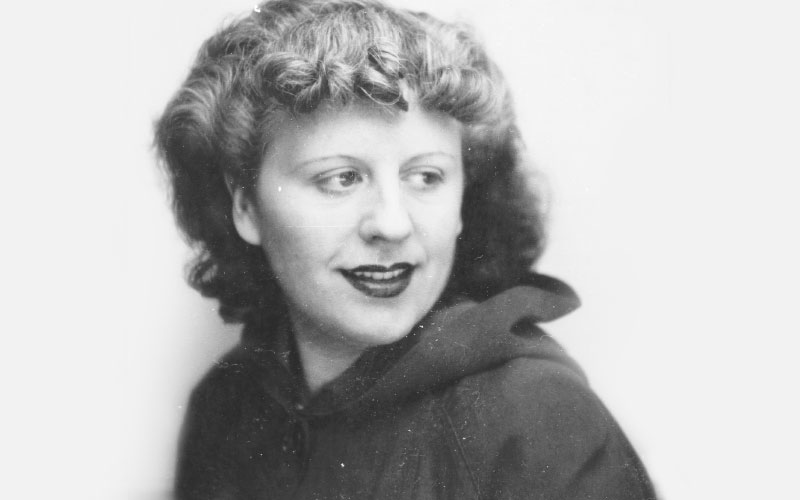
Reproduction of the text: Carme Arnau. Mercè Rodoreda: un viatge entre paraules i flors (Mercè Rodoreda: a Journey through Words and Flowers). Girona;
Foundation Caixa de Girona, 1999. P. 7-16.
As an escape from a life that was too closed and suffocating for her, Mercè Rodoreda began to collaborate with newspapers and magazines, generally with stories, some of them for children: La Publicitat, La Veu de Catalunya, Mirador, etc. Flowers often appear in these stories, as is the case of “The Girl with the Bouquet of Camellias,” where camellias lead to memories, to youth, which would be a constant in Rodoreda’s writing. She also wrote four novels that she later rejected because they reflected her inexperience, showing her strong desire to write, but not much more, as she emphasised in an interview. She only accepted Aloma (1938), which won the 1937 Crexells Award, although even in that case, she completely rewrote it and published a new version in 1969, showing how demanding she was. In the novel, a work of interior analysis, focused on a female figure, an adolescent, Aloma, who lives in a Barcelona that is growing and expanding, but also conflictive, there is a scene that, with variations, would be constant in her writing: a modest home with a garden in the Sant Gervasi neighbourhood, a garden full of flowers. In fact, Aloma’s entry into the world of adults, a world that is always disenchanting for Rodoreda, is represented by the identification of the girl with a wilted flower, and also with the loss of the garden, the only space for happiness, dreaming. It is as if this were a sort of expulsion from an earthly paradise, a garden, as well. And this tie, this identification of female characters with flowers (sometimes they are even named after flowers) would be another constant in Rodoreda’s fiction. The story of a failed first love, Aloma is characterised by some features that would be persistent in her writing: emotion, poeticism, an attempt at symbolism, often focused on flowers and greenery. But this exemplary development, keeping in mind that the author was self-taught, was brought to a halt by the Spanish Civil War, when Rodoreda had to go into exile, which was particularly hard due to the later outbreak of World War II. [...]

A long and difficult exile in France and Switzerland
Reproduction of the text: Carme Arnau. Mercè Rodoreda: un viatge entre paraules i flors (Mercè Rodoreda: a Journey through Words and Flowers). Girona;
Foundation Caixa de Girona, 1999. P. 7-16.
«I was coming out of one of those trips to the end of the night, where writing seems like a horribly frivolous occupation: the flight from Paris, on foot, with incredible sights: the burning of Orleans, the shelling of the port of Beaugency, with cartloads of the dead... two years in Limoges dying every day, like that day, two years in Bordeaux, living there...»
Interview with Baltasar Porcel: Mercè Rodoreda or the Lyrical Force," Serra d'Or (March, 1966)."
In France, she lived in Toulouse and Paris, but when the Germans arrived, she had to flee on foot, facing horrifying sights, particularly the burning of Orleans; fire, in fact, would become another symbol of her work, used to signal destruction, brought about by war, but also the purification that characterises this first material, material that would become progressively important in her work. [...]
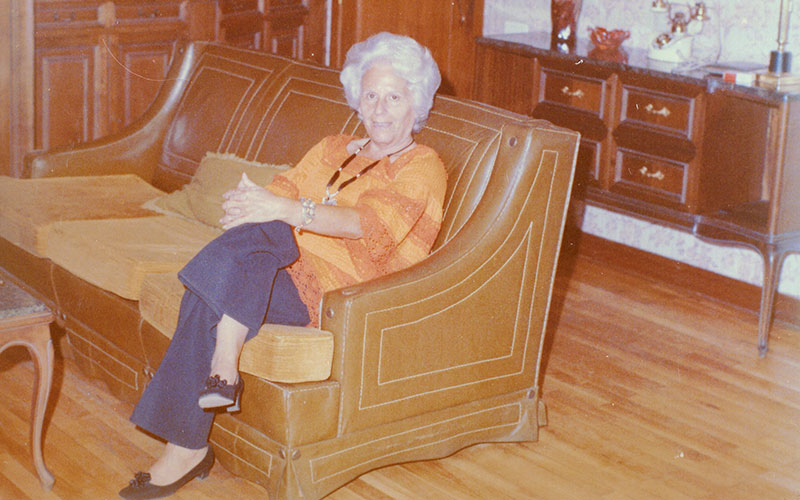
A progressive return beginning in the 1970's: Romanyà de la Selva
Reproduction of the text: Carme Arnau. Mercè Rodoreda: un viatge entre paraules i flors (Mercè Rodoreda: a Journey through Words and Flowers). Girona;
Foundation Caixa de Girona, 1999. P. 7-16.
«The town is sensational. The houses are relatively spread out, located at the top of a light mountain from which you can turn your eyes either to the sea or to the white crest of the Pyrenees»
Mercè Rodoreda. Journey to the Village of Fear," from the collection Viatges i flors (Travels and Flowers)."
In fact, her return to Catalonia was not made to Barcelona, a bilingual, noisy city that she no longer liked, without greenery and especially without gardens, but rather to this quiet little village in the Gavarres, which is located at the top of a permanently green mountain, where she built a house with a garden in a secluded spot at the end of the 1970's. [...]
1908 - 1921
Childhood
1908
Mercè Rodoreda Gurguí was born on 10 October 1908 in a little house with a garden that belonged to her grandfather at Barcelona’s Carrer Sant Antoni, today Carrer Manuel Angelon, in the Sant Gervasi de Cassoles neighbourhood. She was the only child of the married couple formed by Andreu Rodoreda Sallent and Montserrat Gurguí Guàrdia. Her father, an accountant at a gun shop, had always enjoyed the theatre. Her mother felt a certain inclination for music and shared her husband’s enthusiasm for theatre, in a Bohemian ambiance, and together they attended the Escola Catalana d’Art Dramàtic (Catalan School of Dramatic Art), today the Institut del Teatre (Theatre Institute), directed by Adrià Gual, to learn declamation.
1909
Joan Gurguí Guàrdia, Montserrat’s brother, left for Argentina.
1915
-1917Mercè received her primary education at two different schools: the Col·legi de Lourdes, in Sarrià, and another school that was closer to her home, between Carrer Pàdua and Carrer Vallirana. Her foremost teacher, however, was her grandfather, an admirer of Verdaguer and a contributor to the magazine La Renaixença. Rodoreda left school to care for her grandfather when he was taken ill.
1917
She appeared in the play El misteriós Jimmy Samson (Alias Jimmy Valentine), by Paul Armstrong, performed by an amateur theatre group at the Ateneu de Sant Gervasi. Rodoreda played the role of Ketty.
1919
Joan Gurguí corresponded regularly with his family. During his absence, Mercè Rodoreda always looked forward to the arrival of letters from her uncle, whom she eventually came to mythicise.
1921
Mercè’s grandfather, Pere Gurguí, died, and her “uncle in America”, Joan Gurguí, returned to solve the household’s financial problems. His arrival at the Gurguís’ house changed the family’s lifestyle: austerity and conventional order now set the keynote.
Initial forays into writing
1928
On 10th October, her 20th birthday, Mercè married her uncle Joan Gurguí Guàrdia, who was fourteen years her elder, at La Bonanova parish church in Barcelona, with a papal dispensation for the degree of consanguinity. The couple spent their honeymoon in Paris and on their return to Barcelona they moved to Carrer Saragossa.
1929
Jordi, the only child of Mercè Rodoreda and Joan Gurguí, was born on 23rd July. Mercè started to prepare to take her place in society and tried to find a way to make a life for herself with a job that would free her from her financial and social dependence on her husband.
1931
She decided to devote herself to writing and enrolled in the Liceu Dalmau to learn spelling and grammar, aware of the need to improve her expressive skills. She met Delfí Dalmau, who became her first literary and journalistic mentor.
1932
Mercè Rodoreda’s first novel, Sóc una dona honrada? (Am I a Respectable Woman?), was published by Editorial Catalònia, and she also began to write for the press.
1933
Mercè contributed to the weekly Clarisme between October 1933 and June 1934, publishing interviews with writers and artists in addition to city chronicles and travel articles.
1934
She published Del que hom no pot fugir (What You Can’t Escape From) at the Clarisme publishing house and Un dia en la vida d’un home (A Day in the Life of a Man) at Edicions Proa. Mercè began to move in the world of literature through the writer Joan Puig i Ferreter, the director of Proa. She met Andreu Nin and associated with the writers Francesc Trabal, Joan Oliver and Joan Prat, known as Armand Obiols, all of whom had belonged to the group of intellectuals called La Colla de Sabadell and later the Club dels Novel·listes, the same as Rodoreda herself. This year also marked the appearance of the essay Polèmica, by Delfí Dalmau, in which he interviewed Mercè Rodoreda, with an introduction that included some statements giving a foretaste of her literary values.
1935
-1939Rodoreda wrote children’s stories for the weekly page of the daily La Publicitat called “A few moments with the children”, and short stories for La Revista, La Veu de Catalunya and Mirador.
1936
Mercè Rodoreda published her fourth novel, Crim (Crime), which she later came to repudiate, the same as her first three novels.
1937
She started to work as a Catalan-language editor at the Comissariat de Propaganda (Propaganda Commission) of the Generalitat de Catalunya, the Catalan Government. She met the writers Aurora Bertrana and Maria Teresa Vernet and struck up a friendship with Susina Amat, Julieta Franquesa, Anna Murià and Carme Manrubia. Her fifth novel, Aloma, won the Crexells Prize. She wrote psychological stories about the Spanish Civil War and took part in the Women’s Week with the radio broadcast conference “Woman, art and war”. Mercè Rodoreda and her husband, Joan Gurguí, separated this year.
1938
The Institució de les Lletres Catalanes (Institute of Catalan Literature) published Aloma, consolidating Mercè’s reputation as a writer. She travelled to Prague with Francesc Trabal in representation of the PEN Club of Catalonia, reading a greeting there written by the poet Carles Riba. Andreu Rodoreda i Sallent, Mercè’s father, died.
Exile (Part 1)
1939
Rodoreda went into exile on 23rd January, leaving her son with her mother since she thought she would soon be able to return. She left Barcelona together with other intellectuals in a library bus of the Institució de les Lletres Catalanes, which took them to Girona. From there they went to the Mas Perxés farmhouse in Agullana (Alt Empordà region) and then on to Perpignan and Toulouse, finally settling down in an 18th-century château that had been conditioned to shelter refugees, at Roissy-en-Brie, a town near Paris. Mercè lived there for several months with other writers: Anna Murià and her family, C.A. Jordana and his family, Armand Obiols, and Francesc Trabal. This is where the romantic relationship began between Rodoreda and Obiols, her partner in exile. The outbreak of World War II put an end to the situation of stability in Roissy, however, and forced these people to resume their journey: some chose to take exile in Spanish America while others, like Rodoreda and Obiols, decided to remain in Europe.
1940
-1944Flight from Paris as a precaution to the German invasion. During World War II, Mercè Rodoreda settled in Limoges, under precarious conditions, and shortly afterwards she moved to Bordeaux with Armand Obiols, who had been working thereunder German control. During these early years, Mercè made a living by sewing for a department store and wrote stories which she published in magazines in exile.
1946
Rodoreda and Obiols moved to Rue Cherche-Midi, number 21, in Paris, close by the area where the intellectuals gathered in Saint-Germain-des-Prés. She continued to write stories and started to devote herself to poetry. Obiols was in charge of the magazine Revista de Catalunya in exile.
1947
-1953Mercè Rodoreda began to have health problems and suffered a strange paralysis of her right arm, which prevented her from writing as much as she would like. Josep Carner became a mentor and sometimes an editor for her poetry, and Mercè kept up an intense and affectionate correspondence with him. Her poems won various prizes: she received the Natural Flower at the 1947 Floral Games in London; the Natural Flower once again the next year in the Paris Floral Games, and in Montevideo in 1949 she was named “Mestra en Gai Saber” (Master of the Gay Science).
1949
Mercè returned to Barcelona for the first time, to attend to some financial matters connected with the ownership of the house where her mother and her son lived.
1951
Her everyday life in Paris was mainly devoted to reading and painting. She drew close to the work of the most prominent painters of the times: Picasso, Klee, Kandinsky, Miró..., whom she emulated. The circles of friends whom Rodoreda and Obiols mainly frequented were those of Rafael Tasis, Joan Puig i Ferreter and Melcior Font. Rodoreda began to suffer recurrent liver failures, obliging her to make stays at spas and in high-mountain areas.
1952
Treatment at the Chátel-Guyon spa, near Vichy. Here, aside from seeking to recover her health, Mercè started to enjoy a solitude that allowed her to devote herself fully to her creative efforts.
1953
Obiols began to obtain temporary contracts to work as a translator at UNESCO in Geneva. Rodoreda wrote, went often to the cinema and to the Louvre, visited exhibitions and led a certain social life.
Exile (Part 2)
1954
Rodoreda and Obiols established their home in Geneva, where the latter worked as a translator for various United Nations agencies. Rodoreda kept her room in Paris until 1977. The improvement in their finances allowed them to rent an apartment in a middle-class neighbourhood at Rue Vidollet, number 19. Mercè also devoted herself sporadically to painting. Her son married.
1956
Mercè sent three sonnets to Mexico entitled “Evocació dels morts” (Evocation of the Dead), which belonged to the unfinished project Món d’Ulisses (The World of Ulysses). They were accepted and published in Gaseta de Lletres, the literary supplement of La Nova Revista. Literary prize contests for works in the Catalan language were being held in Barcelona once again. Rodoreda won the Joan Santamaria Prize with her short story Carnaval, written in Bordeaux during the war.
1957
Mercè won the Víctor Català Prize for a collection of short stories written in exile, under the title Vint-i-dos contes (Twenty-two Tales), which was published in 1958. If the Santamaria Prize was an encouragement, the Víctor Català Prize marked the final push she needed to continue an oeuvre which was now unstoppable.
1959
She entered Una mica d’història (A Little Bit of History) in the Joanot Martorell Prize contest and it would be published in 1967 under the title Jardí vora el mar (A Garden by Sea). Mercè wrote the short story Rom Negrita (Negrita Rum) for Els 7 pecats capitals vistos per 21 contistes (The Seven Capital Sins as Seen by 21 Short-Story Writers). She began to write Colometa, which was destined to become In Diamond Square (La plaça del Diamant).
1960
Mercè entered Colometa in the Sant Jordi Prize contest. Although she did not win, she obtained the vote of Joan Fuster, who recommended the book to publishing project Club dels Novel·listes, where the director, Joan Sales, took a lively interest in the novel and started to maintain business-related and personal correspondence with Mercè Rodoreda. She worked on Death in Spring (La mort i la primavera) and on Flors de debò (Real Flowers), which would not appear until 1978 in Viatges i flors (Travels and Flowers). Obiols established his permanent residence in Vienna for reasons of work.
1961
Rodoreda entered Death in Spring (La mort i la primavera) in the Sant Jordi Prize contest, failing to win it once again. It would be published posthumously in 1986.
1962
Publication of In Diamond Square (La plaça del Diamant) by Club dels Novel·listes. It proved a big success and a number of editions were printed. Obiols spent practically all his time in Vienna.
1964
Montserrat Gurguí Guàrdia, Mercè Rodoreda’s mother, died.
1965
Mercè Rodoreda wrote to Joaquim Molas on 25th August in reply to his request to start up the publication of her complete works. She refused to have her first four novels published and agreed to rewrite Aloma. Rodoreda began to be recognised outside of Catalonia thanks to the translation of her works. The first book to be translated was In Diamond Square (La plaça del Diamant), in a Spanish edition that appeared that year, followed by translations in English (1967), Italian (1970) and French (1971), among other languages.
1966
Publication of Camellia Street (El carrer de les Camèlies, Club Editor), which obtained the Sant Jordi Prize for 1966. Mercè Rodoreda’s husband, Joan Gurguí, died.
1967
Publication of Jardí vora el mar (A Garden by Sea, Club Editor). Camellia Street (El carrer de les Camèlies) received the Serra d’Or Critics Prize. The collection of short stories My Christina & Other Stories (La meva Cristina i altres contes, Edicions 62) was published. Mercè began working on A Broken Mirror (Mirall trencat).
1968
She purchased a flat at Carrer de Balmes, overlooking Carrer Atenes.
1969
Publication of the new fully rewritten version of Aloma (Edicions 62). Camellia Street (El carrer de les Camèlies) won the Ramon Llull Prize.
1970
The translations of her works began to multiply in the most diverse languages, including those of very remote countries (Japanese, Vietnamese, etc.).
Return to Catalonia
1971
Armand Obiols died in Vienna. Rodoreda was there when this happened.
1972
Mercè Rodoreda’s visits to Barcelona became increasingly frequent. On one of these stays, she spent the summer in the town of Romanyà de la Selva, at El Senyal, the house of her friend Carme Manrubia, and finally came to live there for six years until the construction of her own house in this town was completed in 1978.
1973
Staging of the theatrical adaptation of the short story Record de Caux (A Memory of Caux) by the theatre company Rosec de Dits, in Vic.
1973
-1975Rodoreda finished writing A Broken Mirror (Mirall trencat) in Romanyà and it is published in 1974. She left her flat in Geneva. Mercè started to write War, So Much War (Quanta, quanta guerra...).
1974
Edicions 62 began to publish her Obres completes (Complete Works).
1975
Release of A Broken Mirror (Mirall trencat, Club Editor).
1976
The magazine Els Marges published the play El parc de les magnòlies (Magnolia Park). Carme Arnau wrote the first doctoral thesis about Mercè Rodoreda’s work. A television adaptation of the short story El mirall (The Mirror) was made by Lluís Quinquer, produced by Orestes Lara and directed by Manuel Lara in the RTVE2 series Taller de comèdies (Play Workshop). Rodoreda would rewrite the TV script and turn it into the play El mirall del record (The Mirror of Memory), which is now found in the Archive of the Mercè Rodoreda Foundation.
1978
She published Semblava de seda i altres contes (It Felt Like Silk and Other Short Stories, Club Editor), with stories written from the time of World War II to the death of Obiols together with other more recent stories. Television version of Aloma by Lluís Pasqual, directed by Sergi Schaaff, for the RTVE series Novela (The Novel).
1979
Mercè Rodoreda moved to her house in Romanyà de la Selva. Staging of two of Rodoreda’s plays, La sala de les nines (The Doll Room) and L’hostal de les tres camèlies (The Inn of the Three Camellias), directed by Araceli Bruch.
1980
Rodoreda published War, So Much War (Quanta, quanta guerra..., Club Editor), which won the Serra d’Or Critics Prize, and Viatges i flors (Travels and Flowers, Edicions 62), awarded the Ciutat de Barcelona Prize. In addition to these prizes, Mercè received the Premi d’Honor de les Lletres Catalanes (Prize of Honour of Catalan Literature). The collection Tots els contes (All the Short Stories, Edicions 62) was published. She received the honour of giving the opening speech at Barcelona’s City Festival, Les Festes de la Mercè.
1982
Premiere of the film version of In Diamond Square (La plaça del Diamant), directed by Francesc Betriu. Rodoreda wrote the short biographical sketches Imatges d’infantesa (Images of Childhood), which were published in the magazine Serra d’Or.
1983
Mercè Rodoreda died of cancer in a clinic in Girona on 13th April and was buried in the cemetery of Romanyà de la Selva.
Posteritat
1984
Mercè Rodoreda, segons el testament fet el 1975, fa hereu l’Institut d’Estudis Catalans de la seva propietat intel·lectual, i concedeix les altres propietats i béns a la família.
1984
La revista Els Marges publica, amb el títol «Mercè Rodoreda: obra poètica», vint-i-cinc sonets de Mercè Rodoreda: són els poemes premiats en diverses edicions dels Jocs Florals o en algun altre certamen poètic, i no provenen, per tant, d’una obra rigorosament inèdita.
1985
Publicació de Cartes a l’Anna Murià (Edicions de La Sal).
1986
Es publica La mort i la primavera (Club Editor, segons edició de Núria Folch), la novel·la en què l’escriptora treballava i va restar inacabada en diversos estadis textuals incomplets. Comença així el procés de recuperació de l’obra inèdita i dispersa de Mercè Rodoreda.
L’estació de les dàlies, muntatge teatral sobre textos de Mercè Rodoreda, amb dramatúrgia de Joan Abellan i direcció de Calixto Bieito, es representa al Teatre Adrià Gual de l’Institut del Teatre de Barcelona i a Òmnium Cultural de Vic. Catalunya Ràdio emet la versió radiofònica de Mirall trencat, adaptació de Marta Pessarrodona i direcció de Carme Sansa.
1988
Homenatge a Mercè Rodoreda i inauguració del jardí Mercè Rodoreda, el 21 de juny, a la seu de l’Institut d’Estudis Catalans.
1991
L’Institut d’Estudis Catalans aprova la constitució de la Fundació Mercè Rodoreda, que té per finalitat tenir cura de la figura i l’obra de l’escriptora Mercè Rodoreda, gestionar-ne el patrimoni intel·lectual, i divulgar i promoure els estudis sobre l’autora i la seva obra. La Fundació és també propietària de l’Arxiu Mercè Rodoreda i de la biblioteca que conté tota l’obra editada, en qualsevol llengua, de l’escriptora, tots els estudis i altres materials relacionats. Es representa En veu baixa, basat en textos de Mercè Rodoreda, a càrrec de la companyia Versus Teatre, amb direcció d’Ever Martin Blanchet, a Granollers. Exposició de l’obra plàstica de Mercè Rodoreda al Casal Altarriba de Calldetenes.
1992
Es publica Isabel i Maria (Edicions Tres i Quatre), a cura de Carme Arnau, una novel·la inacabada. Es representa el ballet Aquí no hi ha cap àngel, basat en textos de Mercè Rodoreda, amb coreografia de Ramon Oller i direcció de Joan Castells, companyia Metros, a Barcelona. La Fundació Mercè Rodoreda s’inscriu al Registre de Fundacions de la Generalitat de Catalunya.
1993
S’estrenen a Barcelona dues obres teatrals inèdites: Un dia, dirigida per Calixto Bieito, al Festival Grec, La senyora Florentina i el seu amor Homer, dirigida per Mario Gas, al Teatre Romea. Plaer de dona, basada en textos de Mercè Rodoreda, direcció de Climent Sensada, Companyia GALL, s’estrena a Vic.
1994
Inauguració de l’Arxiu Mercè Rodoreda, el 14 de juny, que actualmente conté 5.605 registres i de la biblioteca 7.796 registres (2025). Representació de Paraula de mulher, amb textos de Mercè Rodoreda, direcció d’Ever Martin Blanchet, a Barcelona.
1996
Representació de Colometa, direcció Bod de Moor, Bruges (Bèlgica)
1997
Es publica en la col·lecció Arxiu de la Fundació, La mort i la primavera, amb edició de Carme Arnau. S’estrenen La place du Diamant, direcció Gilles Bouillon, Companyia Gilles Bouillon, Tours (França), i Mujeres, amb textos de Mercè Rodoreda, direcció de Mercedes Lezcano, Teatro Bulevar Torrelodones (Madrid).
1998
Publicació d’El torrent de les flors, recopilació del teatre de Rodoreda (Edicions Tres i Quatre), a cura de Montserrat Casals. Representació de Le récit de Colometa, direcció de Kristian Trédric, Compagnie Lézards qui bougent, Lió (França).
1999
Representació al Teatre Nacional de Catalunya d’El maniquí, i edició a Proa-Teatre Nacional de Catalunya. TNC
2000
La Fundació publica De foc i de seda. Àlbum biogràfic de Mercè Rodoreda. A cura de Marta Nadal.
2002
Es publica Agonia de llum: la poesia secreta de Mercè Rodoreda (Angle editorial), una selecció de cent sonets editada per Abraham Mohino. Exposició «Mercè Rodoreda, una poètica de la memòria», al Círculo de Bellas Artes de Madrid i edició del catàleg. Estimada Rodoreda, programa de Catalunya Ràdio de lectura de cartes creuades amb Anna Lizaran fent de Mercè Rodoreda. Adaptació televisiva de Mirall trencat, adaptació de Josep M. Benet i Jornet, dirigida per Orestes Lara.
2004
Representació de La plaça del Diamant, adaptació teatral de Joan Ollé i Carles Guillén, direcció Joan Ollé, Bitò Produccions, castell de Peralada.
2007
S'inicia, a la tardor, la celebració de l’Any Rodoreda, amb motiu dels cent anys del naixement de l’escriptora, que es compliran l’octubre de 2008. S’organitzen més de 1.000 activitats.
2008
La Fundació Mercè Rodoreda publica, amb edició i estudi de Roser Porta, les quatre primeres novel·les de l’escriptora (1932-1934), en dos volums. Edicions 62, la Fundació Mercè Rodoreda i l’IEC publiquen les Obres completes de Mercè Rodoreda en dos volums: Narrativa completa, a cura de Carme Arnau. Club Editor publica Cartes completes (1960-1983), correspondència entre Mercè Rodoreda i Joan Sales. Representació de La plaça del Diamant, adaptació de Josep M. Benet i Jornet, i direcció de Toni Casares, Mirall trencat, dramatúrgia de Manuel Molins i Ricard Salvat, direcció Ricard Salvat. Aloma, versió teatral i direcció de Dagoll Dagom.
2009
Exposició «L’altra Rodoreda. Pintures i Collages». La Pedrera, Barcelona
Exposició «Rodoreda, espejo de lenguas». Centre Cultural Blanquerna, Madrid.
2010
La Fundació publica Any Rodoreda. 1908-2008, memòria de les activitats commemoratives, i Congrés Internacional Mercè Rodoreda. Actes. Barcelona, 1-5 d’octubre de 2008. En coedició amb la Institució de les Lletres Catalanes, la Fundació publica Una novel·la són paraules, vint invitacions a la lectura en ocasió del centenari de Mercè Rodoreda 1908-2008, i Mercè Rodoreda: quadern del centenari 1908-2008, a cura d’Abraham Mohino, Mercè Rodoreda i la crítica del seu temps: corpus textual.
2012
La plaça del Diamant (1962), Club Editor, la novel·la més llegida i traduïda de Mercè Rodoreda, fa cinquanta anys. Adaptació i traducció de l’exposició Rodoreda, mirall de llengües. La plaça del Diamant, cinquanta anys, Institut d’Estudis Catalans i Fundació Mercè Rodoreda.
Col·locació de plaques amb el nom de la planta, el nom científic i un fragment de l’obra de Rodoreda al jardí de la Casa de Convalescència.
2013
La Fundació Mercè Rodoreda publica Mercè Rodoreda: entrevistes, a cura d’Abraham Mohino.
2015
Representació de La plaza del Diamante, direcció i adaptació de Joan Ollé. Teatre Goya, Barcelona.
2016
La Fundació Mercè Rodoreda publica Mercè Rodoreda: obra plàstica, a cura de Daniel Giralt-Miracle i M. Rosa Villanueva, i Obra de joventut: narrativa i periodisme, a cura de Carme Arnau i Roser Porta.
2017
La Fundació Mercè Rodoreda publica Cartes de guerra i d’exili (1934-1960), primer volum de l’epistolari de Rodoreda, a cura de Carme Arnau.
2019
Exposició Aloma, commemorativa dels cinquanta anys de la reescriptura d’aquesta obra. La Fundació Mercè Rodoreda publica Teatre, a cura d’Enric Gallén i Gerard Guerra. La Fundació La Mirada publica Cartes a Mercè Rodoreda. Armand Obiols, a cura d’Anna Maria Saludes. Representació de l’adaptació teatral de La mort i la primavera, adaptació i direcció de Joan Ollé, Bitò Produccions, el Temporada Alta (Girona).
2021
La Fundació publica Rodoreda paisatges, a cura de Mercè Ibarz i Carme Esteve. El dia 26 de maig de 2021 es van commemorar cinquanta anys de l’edició de la traducció al francès de La plaça del Diamant publicada per Editorial Gallimard.
2022
Representació de la lectura dramatitzada de l’obra teatral de Mercè Rodoreda El parc de les magnòlies, dirigida per Jordi Prat i Coll, a la seu de l’Institut d’Estudis Catalans.
2023
Es commemoren els quaranta anys de la mort de Mercè Rodoreda. La Fundació Mercè Rodoreda i l’Institut d’Estudis Catalans commemoren aquesta efemèride amb l’audiovisual 40 anys, 40 llengües. Representació de l’espectacle de música i dansa Casa d’àngels, basat en textos de Mercè Rodoreda, a la seu de l’Institut d’Estudis Catalans. La Fundació La Mirada lliura el seu fons documental i editorial a la Fundació Mercè Rodoreda, així com els drets d’autor d’Armand Obiols/Joan Prat. Representació de La plaça del Diamant. Dramatúrgia i direcció de Carlota Subirós al Teatre Nacional de Catalunya. Representació de l’espectacle de petit format Flors i viatges, basat en textos de Mercè Rodoreda, a càrrec de la companyia Cabosanroque, al Teatre Nacional de Catalunya. Representació de Mercè Rodoreda en el triangle de París, dramatúrgia d’Ever M. Blanchet, direcció Maria Casellas, companyia Versus Teatre.
2025
Inauguració del jardí Mercè Rodoreda, una vegada rehabilitat, amb la col·locació de plantes i plaques noves amb el nom de la planta, el nom científic i un fragment de l’obra de Rodoreda al jardí de la Casa de Convalescència, seu de l’Institut d’Estudis Catalans. Inauguració de l’Espai Mercè Rodoreda, dedicat a l’autora, a la seva obra i al seu llegat, que conté mobles, documents i objectes personals de l’escriptora.

